The Best 240Hz Monitors in 2024
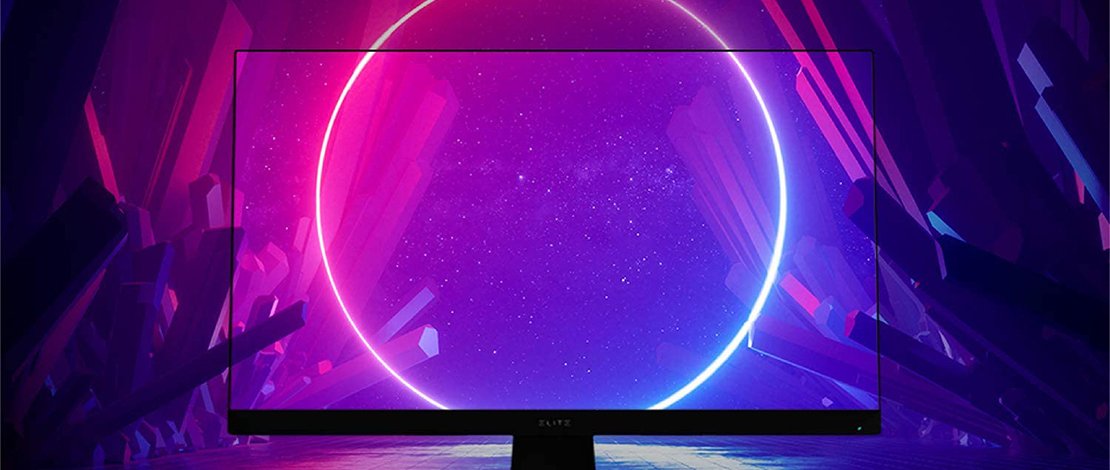
240Hz refresh rate was, until very recently, the holy grail of competitive gaming. Sure, we have 360Hz monitors now but they are very few and far between so if you don’t want to wait for them to start selling or if you want to get a fast refresh rate monitor without paying a massive price premium, you should aim for a 240Hz monitor. And if you want the best 240Hz monitor, check out this list.
We have both 1080p and 1440p panels here, ranging from 25 to 32 inches in size. You can find a couple of curved monitors here but, mostly, these are flat panels. Also, while we’ve included premium models, you can still find a couple of great budget gaming monitors here. Just don’t expect any ultra-budget picks since even budget 240Hz models cost quite a lot. Anyway, let’s begin.
Best 240Hz Monitors
ViewSonic XG2431
The Best 1080P 240HZ Monitor
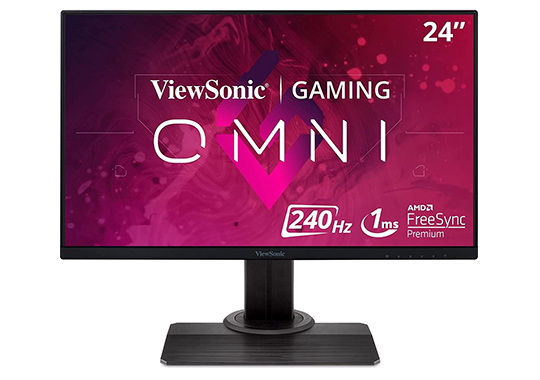
- 1080P 24’’
- IPS 0.5ms
- 240Hz
If you are looking for an excellent 240Hz 1080P display that will offer you great performance while being one of the cheapest options then there is no other choice than the XG2431 from ViewSonic. This monitor is quite popular and is known because it has received the BlurBusters seal of approval meaning it has great clarity and response times for gaming.
This monitor is so good that in certain opinions it even outperforms the ZOWIE XL2546K which by all means was considered the king of 1080P 240Hz monitors when it launched. The look of the monitor is pretty simple but the real star of the show is the IPS panel from Innolux which is quick and offers great motion clarity.
Otherwise the XG2431 is pretty standard with 0.5ms response times, Adaptive-Sync being available, and a nice stand that you can adjust however you want. There are no hidden tricks with the XG2431, you pay for what you get, and you get an amazing gaming experience at 240Hz with no blur.
- Amazing IPS panel from Innolux with great response times
- Almost CRT level clarity during motion
- 240Hz is not quite 360 Hz but it is more than plenty for competitive gaming
- Simple design with a great stand
- The OSD buttons are terrible
BenQ ZOWIE XL2546K
The Monitor Built for eSports
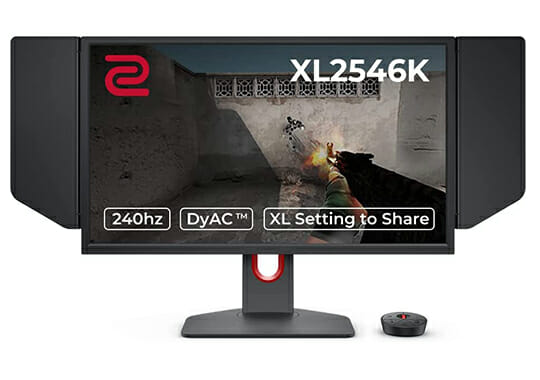
- 1080p 24’’ panel
- TN technology
- DyAC+
- 240Hz refresh rate
One of the mainstay monitors in competitive gaming and eSports has been the BenQ ZOWIE XL2546K. This might be a curiosity for some since this is a TN panel that works at 240Hz and by today’s standards of color accuracy and viewing angles, this panel’s technology and refresh rate are unimpressive.
Then why is this monitor still one of the most sought after in competitive eSports even though it is only 240Hz and uses an older technology? The reason for that is quite simple really – the blur reduction technology and how clear the image is during motion.
Although the TN panel is not the best in terms of color it is the fastest panel in terms of response times and Zowie knows this well. Using their in-house Dynamic Accuracy plus technology (DyAC+) this panel is able to produce the clearest image possible currently during fast motion flicks which is the most important aspect of a monitor for competitive FPS gaming.
Besides the DyAC+ the XL2546K has amazing black equalization which allows you to see people a lot easier in dark areas and has overall good color vibrancy. Another great aspect of this monitor is the on-screen display which is the best on the market with the help of the physical dial the monitor comes with.
The design of the monitor is also eSports oriented with covers for the sides of your monitor, measurements on the stand so you know exactly what was the height of your monitor in case you are moving, and a headphones clip.
What you need to understand is that this is not a monitor for everybody since the color accuracy and reproduction are sub-par with poor viewing angles because of the TN panel to say the least. But if you are looking for the best possible competitive 240Hz monitor that will allow you to click heads the fastest in games then this is the end-game currently.
- Extreme clarity during motion with the DyAC technology
- Great response times on par with every other 240Hz monitor on the market
- Great OSD with a physical switch interface
- Great black equalizer
- Great build quality
- The TN panel really drags this monitor down in terms of casual or professional use therefore you should only really buy the XL2546K if you are only interested in eSports
ASUS TUF Gaming VG279QM
Amazing 240Hz Monitor With a Twist
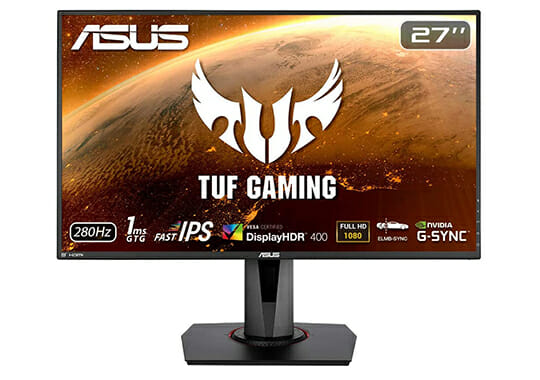
- 1080p 27’’ panel
- IPS technology
- Freesync/G-Sync compatible
- ELMB Sync
- 240-280Hz refresh rate
When it comes to 240Hz gaming monitors that you can confidently use to compete in online environments one monitor that keeps being brought up is the ASUS TUF Gaming VG279QM. This is a 240Hz IPS panel 27’’ monitor that has a little bit of a secret weapon that gives it an edge over the competition.
That specific edge is the capability to factory overclock to 280Hz which is not a huge leap but it is 40 more refreshes per second which are always nice to have. Besides the 280Hz the VG279QM has very good color accuracy and vibrancy, has a very low response time, and almost no blur with the proper settings. These qualities make it a very good 240/280Hz competitive monitor.
The main reason we have chosen the VG279QM (27’’) over the VG259QM (24.5’’) which is a more popular choice because of the pixel density is simply that the 27’’ option has a little bit of an advantage in terms of response times. Strictly speaking in terms of eSports gaming this gives it a slight edge at the cost of lower pixel density.
The monitor obviously has G-Sync and also ELMB sync but these technologies are not exactly the most popular when it comes to competitive gaming although both are quite nice and can be even used together if necessary.
Another interesting part about this monitor is that the VG279QM has a secret factory menu that enables it to use special overdrive settings which result in an amazing performance at 280Hz with almost no blur to be seen.
Overall a very strong contender in the 240Hz monitor market with all the top features necessary to recommend it for casual, work, and competitive gaming.
- Extremely low response times even with G-Sync enabled.
- The jump to 280Hz is a neat feature
- The secret overdrive values allow for extremely good clarity during motion
- Great color accuracy and vibrancy because of the IPS panel
- Some people will not like the lower pixel density of 1080p on a 27’’ monitor even with the small advantage in response times
Dell S2522HG
Solid 240Hz Monitor Option
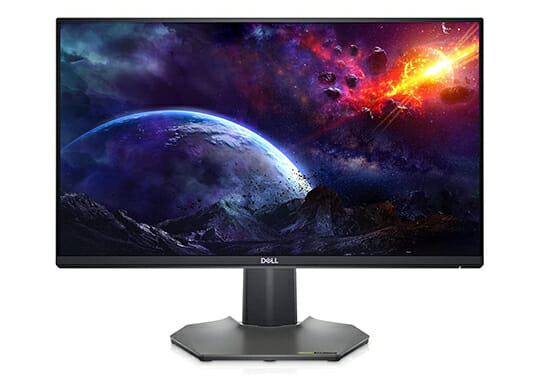
- 1080p 24.5’’ panel
- IPS technology
- Freesync/G-Sync compatible
- 240Hz refresh rate
When it comes to competitive gaming 240Hz 24.5’’ monitors have become a standard and most FPS players consider them a must since they offer a competitive edge. A good monitor that fits this description is the Dell S2522HG, a 240Hz monitor that ticks all of the basic requirements for a good competitive screen.
This Dell monitor uses an IPS panel therefore it has great color accuracy (99%sRGB) and viewing angles without sacrificing the fast response times needed for the rated 1ms. The 24.5’’ 1080p form factor is quite popular because it offers good pixel density and it allows the players to see everything on the screen in one go without having to turn their head.
As with most of these 240Hz monitors the Dell S2522HG also comes with G-Sync/Freesync compatibility which means that if you want, you can experience tear-free gaming at the press of one button.
The stand of the monitor is great with all the adjustability you would ever need and you also get the convenience of having multiple USB ports and a headphone jack installed directly into your monitor.
Overall this is what we would call a strong foundation for a 240Hz monitor that has everything you would need as a competitive gamer while maintaining an understated look which does not screen “gaming monitor”.
- Great viewing angles and color accuracy because of the IPS panel
- The 24.5’’ form factor coupled with a 1080p resolution produces a great pixel density
- 240Hz is arguably the sweet spot currently for competitive gamers
- The S2522HG comes with a lot of commodities like a bunch of I/O and a great stand
- The monitor comes with everything expected of a 240Hz monitor, therefore, does not exactly impress since it does not have any stand-out features
LG 27GP750-B
Another Great 27’’ Gaming Monitor
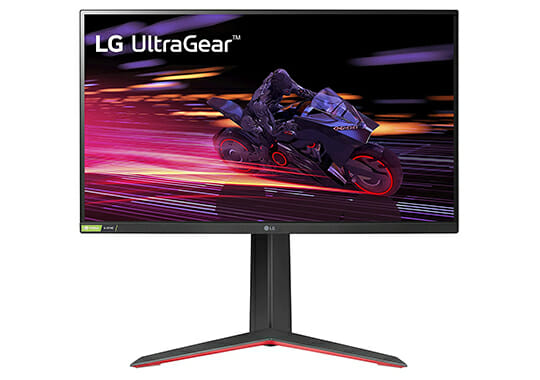
- 1080p 27’’ panel
- IPS technology
- Freesync/G-Sync compatible
- 240Hz refresh rate
When it comes to gaming, certain people simply prefer bigger monitors that make it easier to see targets on the screen. This is in antithesis to the usual idea that competitive gamers prefer 24.5’’ panels but nevertheless, we have to admit that such preferences do exist.
If you are such a person, one great 27’’ competitive monitor is the LG 27GP750-B that luckily has a 1080p resolution which means you can drive high FPS pretty easily in competitive games like CS:GO, Overwatch, Apex Legends, etc. Of course, since this is 27’’ 1080p the pixel density is not great but if you prefer 27’’ monitors you will most likely move it further back from your face resulting in a great experience anyways.
Since this is an IPS panel you get the usual great color accuracy with 99% sRGB coverage and great viewing angles that allow you to crank up that vibrancy and see enemies easier in games without blowing out the colors.
The response time is as expected 1ms and at 240Hz this means you are in line with most other competitive gamers allowing you to focus on in-game mechanics without feeling at a disadvantage hardware-wise. To complete the usual suite of features on modern 240Hz monitors the LG 27GP750-B comes with G-Sync/Freesync allowing for a smoother experience in casual games as well.
Overall this is a device that has all of the features you would expect from a 240Hz monitor neatly packaged in slightly bigger screen size.
- The 27’’ size is great for people that keep their monitors further away from them
- 240Hz 1ms response time is standard for gaming monitors these days
- The overall design is pretty clean with small bezels and a modern look
- The G-Sync/Freesync compatibility allows for casual gaming as well
- A great overall monitor but besides the 27’’ size there is nothing really to separate it from the pack
ASUS ROG PG279QM
Top of the Line 1440p 240Hz Monitor
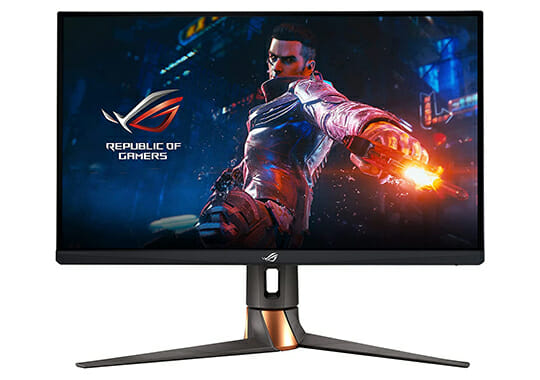
- 1440p 27’’ panel
- IPS technology
- Freesync/G-Sync compatible
- 240Hz refresh rate
- ULMB sync
- Nvidia Reflex Latency Analyzer
If you want a premium 1440p experience in a 27’’ form factor the ASUS ROG PG279QM is most likely your best bet. The main reason is of course the fact that it uses a superb IPS panel that is able to keep up with the 240Hz refresh rate at 1ms making it amazing for competitive gaming but also for media consumption.
The colors are vivid, the viewing angles are great, and the 1440p in a 27’’ form factor has great pixel density allowing for amazing visual clarity in everything you will do. The only real downside is the fact that to push 240FPS at 1440p you will need a beefy computer that rocks the newest hardware.
The monitor comes with ULMB and G-Sync compatibility which allows for a smooth tear and blur-free experience (ULMB comes at the cost of brightness). The monitor also has HDR but as with most monitors lacking the 1000 nits of brightness, this is more of a spec sheet thing than practical usage.
A neat feature of this monitor is the fact that it also comes with the Nvidia Reflex Latency Analyzer that allows you to see an accurate measurement of what is your system latency for better input tweaking resulting in a competitive advantage.
- 27’’ 1440 at is the newest standard of competitive gaming
- 240Hz 1ms response time allows for the smoothest of gaming
- Innovative features like the Nvidia Reflex Latency Analyzer allow you to further tune your system for the lowest input lag
- The ULMB sync allows for less blur but at the cost of brightness
- A premium experience comes at a premium price
SAMSUNG 32-inch Odyssey G7
The Best 240Hz Gaming Monitor
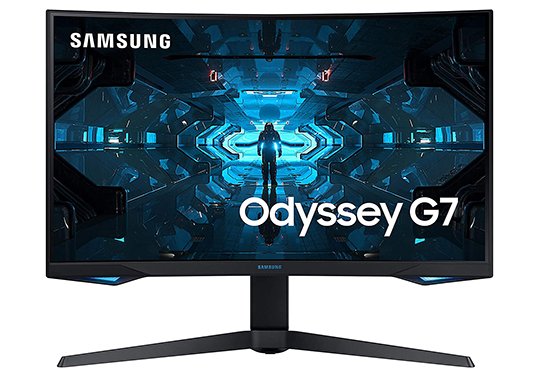
- Size: 32 Inches
- Resolution: 2560×1440
- Panel Type: VA
- Advertised Response Time: 1ms
- Ports Included: 2xDisplayPort; 1xHDMI
VA panels aren’t the best for high-performance gaming monitors but Samsung managed to create a VA panel that has almost zero ghosting and smearing, making the panel fully compatible with a 240Hz refresh rate. The result are the new monitors from the Odyssey line and the 32-inch Odyssey G7 is the best 240Hz monitor you can get right now. It bumps the resolution up to 1440p, presenting a rare 240Hz gaming monitor that features 1440p resolution.
Thanks to Samsung’s engineering proves the Odyssey G7 has an amazing image quality with close to zero blur and with excellent colors and deep blacks. Overall, this is an almost complete package when it comes to 240Hz monitors. The only thing dragging it down are narrow viewing angles, which is something you cannot avoid when using a VA panel. But everything else rocks. The colors are great and the blacks are quite deep. Response time is unbelievable for a VA panel. FreeSynch and G-Sync work great (although there are reports about backlight flickering when using VRR modes), and build quality is top-notch.
The stand allows for height adjustment, switching between landscape and portrait, swivel, and tilt. When it comes to downsides you have the aforementioned narrow viewing angles as well as lots of reports about backlight flickering. Further, the aggressive 1000R curve (the smaller the number the narrower the curve) is not for everyone. HDR performance is also pretty limited. Finally, we have a high price point. But overall, this is an amazing 240Hz monitor with excellent colors, deep blacks, next to zero ghosting and smearing, as well as great build quality. If you want a 1440p 240Hz gaming monitor with great colors, excellent response time, and deep blacks all in one package, this is about the only monitor that offers it all.
- Excellent Gaming Performance For A VA Panel
- Great Colors And Deep Blacks
- 1440P and 240Hz Refresh Rate Go Great Together
- FreeSync And G-Sync Support
- Pretty Good Build Quality
- The Curve May Be Too Aggressive For Some Users
- Average HDR Performance
- High Price
How To Choose A 240Hz Monitor
Since 240Hz monitors are used mostly for gaming, you should focus on stuff like the response time and input lag. Also, make sure that colors and contrast are at least decent, which is also needed for a great gaming experience.
Another important thing to watch is the maximum brightness. Let’s say that about 250 nits is the minimum for using a monitor in a brightly lit room. Everything over 300 nits is excellent for any room. Finally, many monitors have low blue light modes but you can get some additional protection by wearing reflective glasses.
We already have an in-depth monitor buying guide which you can read by visiting our list of the best budget gaming monitors. Here we will only cover the most important things to look for when specifically buying a 240Hz monitor.
You Might Not Even Need A 240Hz Gaming Monitor
For most games, the 144Hz refresh rate is more than enough. But, if you’re a hardcore esports gamer and have the hardware that can run games you play at 240Hz, go for it. The thing is, the difference is very hard to see and if you’re playing mostly single-player games, a 144Hz or 120Hz monitor with better colors and higher (1440p or 4K) resolution might be a better choice.
Make Sure That The Panel Used Can Keep With The 240Hz Refresh Rate
240Hz panel equals a refresh rate of just 4,16 milliseconds. That’s about the same as the response rates found on the fastest gaming monitors today (measured response times, not advertised). This means that not all panels are capable of pushing 240Hz without ghosting or image smearing.
So, if you’re looking for a 240Hz monitor focus on response time and presence of any ghosting or image smearing. While most 240Hz monitors use either IPS or TN panels, both of which are more than suited for a 240Hz refresh rate, some budget models may have slower panels that aren’t completely capable of following the blazing-fast 240Hz refresh rate.
Also, while there are just a few 240Hz models with a VA panel we might get more 240Hz VA monitors in the future. Since the VA panel technology is the one with the slowest response time on average, be extra focused on the response time and ghosting if you’re interested in a VA 240Hz monitor.
If You Plan On Getting A 27-Inch 1080p 240Hz Monitor, Check One Out In Person
While the 1080p resolution on a 27-inch monitor looks fine for many users and can even give you a slight advantage when playing multiplayer titles but for some people 1080p on a 27-inch panel is just too blurry.
If you didn’t have the chance to look at or use a 27-inch 1080p monitor you should definitely check one out in person if you’re interested in getting a 240Hz 1080p 27-inch monitor. Also, since monitor QA these days is less than ideal, even for flagship models, be sure to get a monitor from a place that accepts no question asked returns.
Watch For Contrast, Colors, And Backlight Bleed If You Want To Do Other Stuff Than Gaming
If you’re someone who only plans to play competitive shooters on a 240Hz monitor, look for response time and input lag and make sure that colors and contrast aren’t awful. But, if you want to use the monitor for watching movies or for color-accurate work, make sure that colors are accurate, that the monitor offers a wide color gamut and wide viewing angles, and that the contrast ratio is at least 1000:1. While super accurate colors and high contrast aren’t that important for playing frantic multiplayer titles, enjoying movies, doing stuff in Photoshop, or playing slower paced single-player titles can greatly benefit from accurate colors and decent contrast ratio.
Other Stuff To Focus On When Buying A 240Hz Monitor
Remember that there are lots of curved gaming monitors out there. Some people don’t like their monitor to have any curve while others don’t mind it. It’s best to check out for yourself if possible before pulling the trigger on a curved monitor.
When it comes to the HDR experience, it’s average at best on 240Hz monitors. These are gaming models so HDR isn’t as important as other features. If you want a great HDR experience look for high-end monitors that are at least 32-inch or larger, or get a high-end TV.
Last but not least, check which ports are offered on the monitor you’re interested in. If you have a gaming console or two, you want at least three video inputs, two of which should be HDMI. Also, many mid-range and high-end monitors come with USB hubs on their back, so if you need a USB hub check whether the monitor you want to get has one.